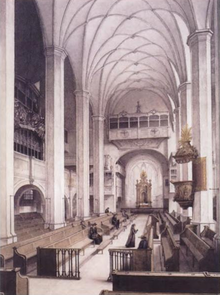Loading AI tools
Cantata by Johann Sebastian Bach From Wikipedia, the free encyclopedia
Gottlob! nun geht das Jahr zu Ende (Praise God! Now the year comes to an end),[1] BWV 28,[lower-alpha 1] is a church cantata by Johann Sebastian Bach for the Sunday after Christmas. He first performed it on 30 December 1725.
| Gottlob! nun geht das Jahr zu Ende | |
|---|---|
BWV 28 | |
| Church cantata by J. S. Bach | |
 Thomaskirche, Leipzig 1885 | |
| Occasion | 1st Sunday after Christmas |
| Performed | 30 December 1725: Leipzig |
Bach composed the cantata in his third year as Thomaskantor in Leipzig for the Sunday after Christmas. The prescribed readings for the Sunday were from the Epistle to the Galatians, through Christ we are free from the law (Galatians 4:1–7), and from the Gospel of Luke, Simeon and Anna talking to Mary (Luke 2:33–40).[2]
The cantata text is by Erdmann Neumeister:[3] he included in the second movement the first stanza of Johann Gramann's hymn "Nun lob, mein Seel, den Herren" (1530),[3] a Bible quotation (Jeremiah 32:41) in the third movement, and a hymn stanza by Paul Eber for the closing chorale.[3][4] The chorale theme "Helft mir Gotts Güte preisen" (Zahn 5267) is of unknown authorship. The poet did not refer to the Bible readings for the day but portrayed thanks for the past year and prayers for preservation in the new year.[5]
Bach first performed the cantata on 30 December 1725.[3]
Bach structured the cantata in six movements, scored for four vocal soloists (soprano, alto, tenor, bass) and four-part choir, and a Baroque instrumental ensemble of cornetto, three trombones, two oboes, taille, two violins, viola and continuo.[3][6]
| No. | Title | Type | Vocal | Winds | Strings | Others / Brass | Key | Time |
|---|---|---|---|---|---|---|---|---|
| 1 | Gottlob! nun geht das Jahr zu Ende | Aria | Soprano | 2 oboes, taille | 2 violins, 1 viola | continuo | A minor | 3/4 |
| 2 | Nun lob, mein Seel, den Herren | Chorale | SATB | 1 oboe (col soprano), 1 oboe (coll'alto), cornetto (col soprano), taille (col tenore) |
1 violin (col soprano), 1 violin (coll'alto), viola (col tenore) |
1 trombone (coll'alto), 1 trombone (col tenore), 1 trombone (col basso) continuo |
C major | |
| 3 | So spricht der Herr | Recitative / arioso | Bass | continuo | ||||
| 4 | Gott ist ein Quell | Recitative | Tenor | 2 violins, viola | continuo | |||
| 5 | Gott hat uns im heurigen Jahre gesegnet | Duet | Alto / Tenor | continuo | C major | 6/8 | ||
| 6 | All solch dein Güt wir preisen | Chorale | SATB | 1 oboe (col soprano), 1 oboe (coll'alto), cornetto (col soprano), taille (col tenore) |
1 violin (col soprano), 1 violin (coll'alto), viola (col tenore) |
1 trombone (coll'alto), 1 trombone (col tenore), 1 trombone (col basso) continuo |
A minor |
The cantata opens with an oboe trio playing an Italianate ritornello of four phrases, accompanied by the strings; the roles of the two choirs are later reversed. The soprano sings a virtuosic and melismatic aria commanding the listener to praise God.[7][8]
The following chorale expands the command from the individual to the collective, adopting an "archaic" motet form. It is reminiscent of the movements which opened most of Bach's chorale cantatas, composed as a cycle the previous year. The cantus firmus is sung in long notes by the soprano while the lower voices add "skilful imitatory texture, partly from new themes and partly from ideas derived from the chorale line in question", as Klaus Hofmann notes.[5][9] The instruments play colla parte in motet style with the voices, doubled by a quartet of cornetto and trombones.[5] The music in stile antico was performed at the end of John Eliot Gardiner's Bach Cantata Pilgrimage in 2000, who described its "sobriety and complexity, its buried treasures and subtleties, especially those that occur in its last fifty bars, in which you sense some immense cosmic struggle being played out".[10]
The third movement, a bass arioso, repeats the ascending scalar motif of the chorus. The tenor recitative is accompanied by sustained chordal strings and concludes on a major harmony. The continuo opens the duet aria with a two-part ritornello – dancing eighth notes followed by fast arpeggiated figures – that is repeated three more times during this movement. The vocal lines sing three blocks of imitative motivic entries.[7] In the style of Italian chamber duets, the voices first render a thought in imitation, "coming together each time for a concluding cadence".[5]
The cantata concludes with a four-part chorale in A minor.[7] Gardiner, who had conducted several versions during the Pilgrimage, notes the moving power of this harmonisation of the "prayer for protection and sustenance in the year to come".[10]
Seamless Wikipedia browsing. On steroids.
Every time you click a link to Wikipedia, Wiktionary or Wikiquote in your browser's search results, it will show the modern Wikiwand interface.
Wikiwand extension is a five stars, simple, with minimum permission required to keep your browsing private, safe and transparent.